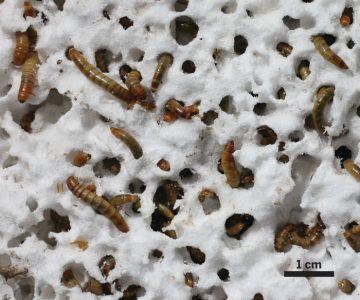Anne Sverdrup-Thygeson in Delancey Place:
 “Every minute enough plastic is dumped into the world’s oceans to fill an entire dump truck. At least as much again ends up in landfill sites, and the amounts are constantly increasing. Because we love plastic. It’s handy and cheap. We produce and use twenty times as much plastic every year now as we did fifty years ago, and less than 10 percent of it is recycled. The rest of the plastic waste ends up in landfills, in roadside ditches, or in the sea. A report issued by the Ellen MacArthur Foundation estimated that if this continues the sea will contain more plastic than fish by 2050. This is because plastic biodegrades extremely slowly in the natural environment. So the discovery that a number of insects can digest and break down plastic is something of a sensation.
“Every minute enough plastic is dumped into the world’s oceans to fill an entire dump truck. At least as much again ends up in landfill sites, and the amounts are constantly increasing. Because we love plastic. It’s handy and cheap. We produce and use twenty times as much plastic every year now as we did fifty years ago, and less than 10 percent of it is recycled. The rest of the plastic waste ends up in landfills, in roadside ditches, or in the sea. A report issued by the Ellen MacArthur Foundation estimated that if this continues the sea will contain more plastic than fish by 2050. This is because plastic biodegrades extremely slowly in the natural environment. So the discovery that a number of insects can digest and break down plastic is something of a sensation.
“Take polystyrene, for example. Even if you don’t think you use it often, I’m guessing that you’ve held some in your hand — if you’ve ever bought takeout food in a carton or a hot drink in anything other than a paper cup. Because polystyrene, also known as isopore, is the material used to make disposable containers for hot food and drink. In the United States alone, 2.5 billion such cups are thrown away every year — and we’re talking about a material that was thought to be nonbiodegradable. Until now. Because it turns out that mealworms consume isopore cups as if they were part of their regular diet.
“In one study, several hundred American and Chinese mealworms were served some isopore. All of them belonged to the darkling beetle species (Tenebrio molitor), which lives outdoors in most parts of the world and sometimes turns up indoors, too, if any soggy flour residue is left lying in your cupboards for too long. They gobbled up the isopore at record speed, and the larvae raised on this peculiar diet pupated and hatched into adult beetles as normal. Within a month, for example, five hundred Chinese mealworms had gobbled up a third of the 5.8 grams of isopore served up to them. All that was left was some carbon dioxide and a spot of beetle poo, which was apparently pure enough to use as planting soil. There was no difference between the survival rates of larvae that received normal food and those on the isopore diet.
More here.
